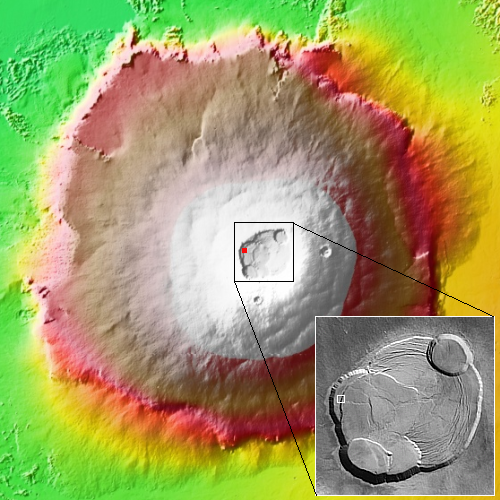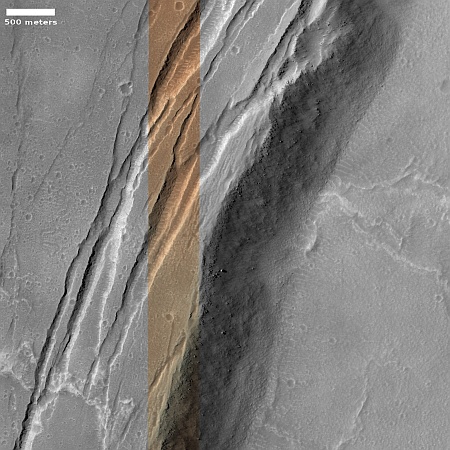The mighty scale of Mars’ geology
Today’s cool image is just one more example out of hundreds I have posted in the past decade of the difficult-to-imagine gigantic scale of the Martian landscape.
The picture to the right, rotated, cropped, reduced, and sharpened to post here, was taken on March 1, 2025 by the high resolution camera on Mars Reconnaissance Orbiter (MRO). The image title is simple, “Steep Slopes of Olympus Mons Caldera,” and tells us that this cliff face, about 1,300 feet high, is part of the caldera that resides on top of Mars’ largest volcano, Olympus Mons.
The parallel cracks on the plateau above the cliff tell us that the cliff face is slowly separating outward from that plateau, and that at some point in the future the entire wall will collapse downward.
Sounds impressive and big, eh? What the picture doesn’t make clear however is how truly tiny this cliff is in the context of the entire mountain.

The red dot on the overview map to the right marks the location, on a small lower cliff inside Olympus Mons’ 50-mile-wide caldera. Though 1,300 feet high, this cliff is dwarfed by the landscape around it. The actual edge of the caldera, about two miles to the west, is a cliff face four to five times higher. The plateau at the top of this larger cliff forms the relatively flat peak of Olympus Mons, which sits 70,000 feet above Mars’ mean “sea level,” more than twice as high as Mount Everest on Earth.
And yet, as I noted in 2022,
… the scale of this mountain would make the skill to climb it more in line with a hard core hiker than a mountain climber. At few points from bottom to top would you ever have to scale a cliff. Instead, the journey would be one long, long, long trudge up a never-ending slope, running almost 300 miles from base to peak. Even the mountain’s edge, that seems so much like a cliff, is actually less a cliff and more a somewhat steeper slope. All you’d need at a few points is to switch back a few times to lessen the grade.
To get down into the caldera however might require some rock-climbing ability, though upon close inspection I suspect a hiking route could still be found down these cliffs.
Mars is big in all ways. It helps illustrate the vastness of the universe, on a scale that we humans can actually understand.
On Christmas Eve 1968 three Americans became the first humans to visit another world. What they did to celebrate was unexpected and profound, and will be remembered throughout all human history. Genesis: the Story of Apollo 8, Robert Zimmerman's classic history of humanity's first journey to another world, tells that story, and it is now available as both an ebook and an audiobook, both with a foreword by Valerie Anders and a new introduction by Robert Zimmerman.
The print edition can be purchased at Amazon or from any other book seller. If you want an autographed copy the price is $60 for the hardback and $45 for the paperback, plus $8 shipping for each. Go here for purchasing details. The ebook is available everywhere for $5.99 (before discount) at amazon, or direct from my ebook publisher, ebookit. If you buy it from ebookit you don't support the big tech companies and the author gets a bigger cut much sooner.
The audiobook is also available at all these vendors, and is also free with a 30-day trial membership to Audible.
"Not simply about one mission, [Genesis] is also the history of America's quest for the moon... Zimmerman has done a masterful job of tying disparate events together into a solid account of one of America's greatest human triumphs."--San Antonio Express-News
Today’s cool image is just one more example out of hundreds I have posted in the past decade of the difficult-to-imagine gigantic scale of the Martian landscape.
The picture to the right, rotated, cropped, reduced, and sharpened to post here, was taken on March 1, 2025 by the high resolution camera on Mars Reconnaissance Orbiter (MRO). The image title is simple, “Steep Slopes of Olympus Mons Caldera,” and tells us that this cliff face, about 1,300 feet high, is part of the caldera that resides on top of Mars’ largest volcano, Olympus Mons.
The parallel cracks on the plateau above the cliff tell us that the cliff face is slowly separating outward from that plateau, and that at some point in the future the entire wall will collapse downward.
Sounds impressive and big, eh? What the picture doesn’t make clear however is how truly tiny this cliff is in the context of the entire mountain.

The red dot on the overview map to the right marks the location, on a small lower cliff inside Olympus Mons’ 50-mile-wide caldera. Though 1,300 feet high, this cliff is dwarfed by the landscape around it. The actual edge of the caldera, about two miles to the west, is a cliff face four to five times higher. The plateau at the top of this larger cliff forms the relatively flat peak of Olympus Mons, which sits 70,000 feet above Mars’ mean “sea level,” more than twice as high as Mount Everest on Earth.
And yet, as I noted in 2022,
… the scale of this mountain would make the skill to climb it more in line with a hard core hiker than a mountain climber. At few points from bottom to top would you ever have to scale a cliff. Instead, the journey would be one long, long, long trudge up a never-ending slope, running almost 300 miles from base to peak. Even the mountain’s edge, that seems so much like a cliff, is actually less a cliff and more a somewhat steeper slope. All you’d need at a few points is to switch back a few times to lessen the grade.
To get down into the caldera however might require some rock-climbing ability, though upon close inspection I suspect a hiking route could still be found down these cliffs.
Mars is big in all ways. It helps illustrate the vastness of the universe, on a scale that we humans can actually understand.
On Christmas Eve 1968 three Americans became the first humans to visit another world. What they did to celebrate was unexpected and profound, and will be remembered throughout all human history. Genesis: the Story of Apollo 8, Robert Zimmerman's classic history of humanity's first journey to another world, tells that story, and it is now available as both an ebook and an audiobook, both with a foreword by Valerie Anders and a new introduction by Robert Zimmerman.
The print edition can be purchased at Amazon or from any other book seller. If you want an autographed copy the price is $60 for the hardback and $45 for the paperback, plus $8 shipping for each. Go here for purchasing details. The ebook is available everywhere for $5.99 (before discount) at amazon, or direct from my ebook publisher, ebookit. If you buy it from ebookit you don't support the big tech companies and the author gets a bigger cut much sooner.
The audiobook is also available at all these vendors, and is also free with a 30-day trial membership to Audible.
"Not simply about one mission, [Genesis] is also the history of America's quest for the moon... Zimmerman has done a masterful job of tying disparate events together into a solid account of one of America's greatest human triumphs."--San Antonio Express-News



Well said, Bob.
Shouldn’t that be “areology”?
Manfred Mann, help me out, here:
“You’ve not seen nothin’ like the mighty ridge”
I know its a Dylan song, but the Mann version was more popular, and the one I remember.